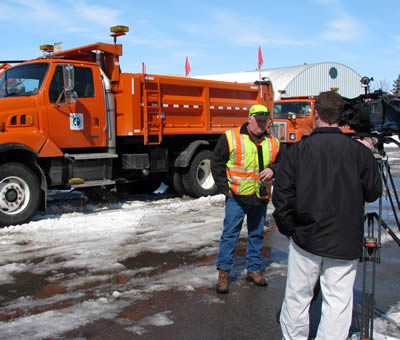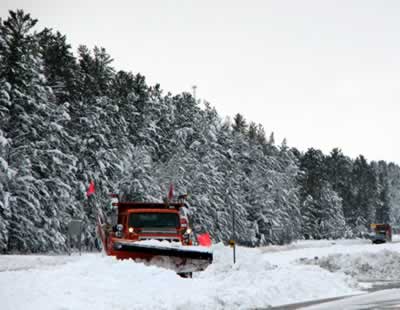By Craig Wilkins

Don White, a senior transportation generalist at Detroit Lakes, speaks with a TV news reporter following the massive snow storm. Photo by Judy Jacobs |
Virginia, the Queen City of the North, was belted by a king-sized blast of snow that covered northern Minnesota on April 6-7.
Virginia received 32 inches, the heaviest snowfall recorded in the state. Snow accumulations reached two feet or more in other Iron Range cities and all across most of the state’s northern tier.
Mn/DOT districts scrambled maintenance crews on Sunday to take on the storm initially predicted to bring an eight- to nine-inch accumulation. But the snow kept on falling, as fast as one or more inches per hour in some locations.
Bob Wryk, District 1 maintenance superintendent at Virginia, said the dense snow compacted quickly.
“We threw everything we had at it—underbody plows, loaders, scrapers and a little chemical. We didn’t want to use too much salt because temperatures in the 30s were in our favor and helped melt the snow quickly,” Wryk said.
Wryk credited warm temperatures and his crews’ hard work in returning district highways to service.
“I just moved up north from the Metro District to Bemidji in 2006 and over here in March,” Wryk said, “but even the veteran maintenance people said this storm is a very unusual event.”
Patrol officers keep motorists from passing plows in District 4
Don White, a senior transportation generalist at Detroit Lakes, said his crew at Detroit Lakes had to suspend operations occasionally due to poor visibility.
“It was hard to see through the windshield at times because the snow was coming so fast, and that was during the daytime,” he said.
From time to time, White said, State Patrol officers followed the plows to keep truckers and other motorists from passing them.
When drivers got ahead of the plows, he said, many would get stuck in the middle of the road or slide off onto the shoulder.
Bemidji snowfighters also battle fallen trees, branches

A District 2 worker clears a crossover on Hwy 2 east of Bemidji. Photo by Karen Bedeau |
In District 2, Don Holt, a sub-area supervisor at Bemidji, said the storm started with rain on the evening of April 5 while he was patrolling near Walker.
“The rain turned to sleet and then to snow and slush,” Holt said. “By the time I got back to Bemidji we had a full-scale snowstorm going.”
The dense snow dropped as much as 26 to 29 inches of snow in parts of the district, creating a major league challenge to the district’s maintenance forces.
Holt alerted his crews at midnight on April 6, urging them to use as little salt and other chemicals as possible.
Trees that collapsed from the snow collected in their branches in many locations, adding to the stress of clearing roads in the hard-hit district. Crews often had to stop and clear fallen trees and branches before they could resume plowing, Holt said.
“Many of the roads in our district are in national forests which limit our options as far as trimming the trees back,” he said.
Holt said the district’s efforts to regain service on its roads drew positive comments from the public, the State Patrol and the news media.
Heavy snow recharges groundwater, lakes and rivers
The storm created a lot of stress and overtime, but Wryk sees at least one silver lining from all those snow clouds.
“The storm brought the equivalent of two or three inches of water,” he said. “That’s good for recharging our lakes, streams and rivers.”
District 4’s White marveled at how fast the roads went from being covered with compacted snow to bare and dry.
“We had road temperatures in the 60s and air temperatures in the 30s, which really helped us a lot,” he said.
White said no one in the district is going to take their plows and sanders off soon.
“The roads are clear right now,” he said, “but there’s another storm predicted for Thursday, so we’ll just have to wait for that.”
|



